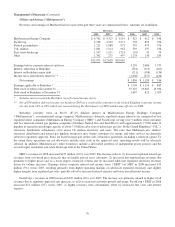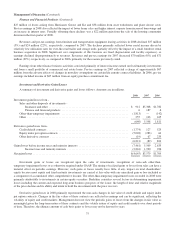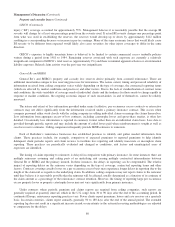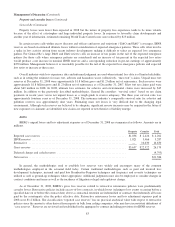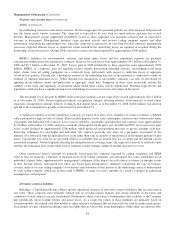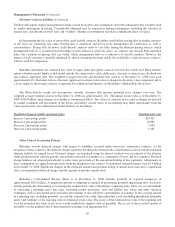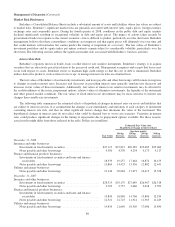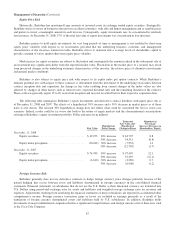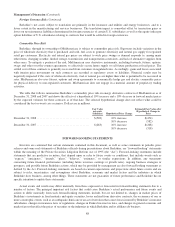Berkshire Hathaway 2008 Annual Report Download - page 80
Download and view the complete annual report
Please find page 80 of the 2008 Berkshire Hathaway annual report below. You can navigate through the pages in the report by either clicking on the pages listed below, or by using the keyword search tool below to find specific information within the annual report.
Management’s Discussion (Continued)
Critical Accounting Policies
Certain accounting policies require management to make estimates and judgments concerning transactions that will be
settled several years in the future. Amounts recognized in the financial statements from such estimates are necessarily based on
numerous assumptions involving varying and potentially significant degrees of judgment and uncertainty. Accordingly, the
amounts currently reflected in the financial statements will likely increase or decrease in the future as additional information
becomes available.
Property and casualty losses
A summary of Berkshire’s consolidated liabilities for unpaid property and casualty losses is presented in the table below.
Except for certain workers’ compensation reserves, liabilities for unpaid property and casualty losses (referred to in this section
as “gross unpaid losses”) are reflected in the Consolidated Balance Sheets without discounting for time value, regardless of the
length of the claim-tail. Amounts are in millions.
Gross unpaid losses Net unpaid losses *
Dec. 31, 2008 Dec. 31, 2007 Dec. 31, 2008 Dec. 31, 2007
GEICO ..................................................... $ 7,336 $ 6,642 $ 7,012 $ 6,341
General Re .................................................. 18,241 19,831 17,235 17,651
BHRG ..................................................... 26,179 24,894 21,386 20,223
Berkshire Hathaway Primary Group .............................. 4,864 4,635 4,470 4,127
Total ....................................................... $56,620 $56,002 $50,103 $48,342
*Net of reinsurance recoverable and deferred charges reinsurance assumed and before foreign currency translation effects.
Berkshire records liabilities for unpaid losses and loss adjustment expenses under property and casualty insurance and
reinsurance contracts based upon estimates of the ultimate amounts payable under the contracts with respect to losses occurring
on or before the balance sheet date. The timing and amount of loss payments is subject to a great degree of variability and is
contingent upon, among other things, the timing of claim reporting from insureds and cedants and the determination of the
ultimate amount through the loss adjustment process. A variety of techniques are used in establishing the liabilities for unpaid
losses. Regardless of the techniques used, significant judgments and assumptions are necessary in projecting the ultimate
amounts payable in the future. As a result, uncertainties are imbedded in and permeate the actuarial loss reserving techniques
and processes used.
As of any balance sheet date, not all claims that have occurred have been reported and not all reported claims have been
settled. Loss and loss adjustment expense reserves include provisions for reported claims (referred to as “case reserves”) and for
claims that have not been reported (referred to as incurred but not yet reported (“IBNR”) reserves). The time period between the
loss occurrence date and settlement payment date is referred to as the “claim-tail.” Property claims usually have fairly short
claim-tails and, absent litigation, are reported and settled within a few years of occurrence. Casualty losses usually have very
long claim-tails, occasionally extending for decades. Casualty claims are more susceptible to litigation and can be significantly
affected by changing contract interpretations. The legal environment further contributes to extending claim-tails.
Receivables are recorded with respect to losses ceded to other reinsurers and are estimated in a manner similar to liabilities
for insurance losses. In addition to the factors cited above, reinsurance recoverables may ultimately prove to be uncollectible if
the reinsurer is unable to perform under the contract. Reinsurance contracts do not relieve the ceding company of its obligations
to indemnify its own policyholders.
Berkshire’s insurance businesses utilize loss reserving techniques that are believed to best fit the particular business.
Additional information regarding reserving processes of the significant businesses (GEICO, General Re and BHRG) follows.
GEICO
GEICO’s gross unpaid losses and loss adjustment expense reserves as of December 31, 2008 were $7,336 million. As of
December 31, 2008, gross reserves included $5,265 million of reported average, case and case development reserves and $2,071
million of IBNR reserves.
78




